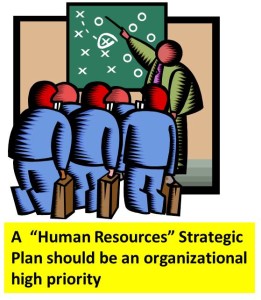
Too many people consider Human Resources within an enterprise as one of those necessary evils that one must have to stay out of trouble. In reality, Human Resources should be considered one of the most critical functions at the center of building competitive advantage and business success. Why? Because for most companies, expenditure on people is the single largest area of investment. (See my earlier blog on this.) And isn’t it interesting that financial executives spend so much time and energy looking at inventory turns, investment of access cash and building / land investments instead of investment in their people?
Therefore, Human Resource Management should be one of the critical core functions present at the highest levels of corporate leadership. At a Raleigh-Wake Human Resources Management Association chapter meeting I attended over a year ago, former SHRM (Society of Human Resource Management) president Johnny Taylor, Jr. presented “Courageous HR” (link to blog) discussing how HR managers need to be more bold in demonstrating leadership and providing significant impact on a company’s success.
And now to kick off 2014, the Triangle Society of Human Resources Management (TSHRM) presented an excellent speaker, Molly Hegeman, VP of HR Services for CAI (link), on “Strategic Planning: A practical way to focus on what is important.” This meaty session provided a structured practical approach to HR professionals strategically planning and aligning the Human Resources function with corporate goals.

Molly began with a definition of strategic planning: “a systematic process for ensuring a desired future and translating this vision into broadly defined goals and objectives along with a sequence of steps to achieve them.”
Molly’s presentation included the four steps for Strategic HR Planning:
1. Assessing the current human resources capacity of the organization – where are we?
2. Forecasting future human resources needs , which includes both the employee requirements or demand needed to achieve corporate goals as well as current supply.
3. Completing a gaps analysis which is documenting what is missing or needs to be improved on from the current state to achieve future goals.
4. Ensuring that HR strategies and execution can leverage existing capacity and develop new resources to meet requirements.
In addition, Molly summarized the important industry trends that need to be considered while doing strategic planning. These trends included:
• The impact of corporate culture on attracting and retaining employees
• Impact of the overall work climate
• The focus on differentiating, rewarding, retaining the top performers
• Truly paying for performance, for impact, contribution
• Emerging variable pay plans and flexible scheduling
Of course there was so much more in this session than can be covered in this short blog. She covered practical suggestions on how to do this and the importance of communication along the way.
In part 2, I will expand on how my two areas of expertise, diversity and career development, are central to human resource strategic planning and corporate success.
# # # #
Molly Hegeman is VP of HR Services for CAI (link). CAI is a trusted resource for HR, compliance and people development serving approximately 1,100 member companies in Eastern and Central North Carolina.

